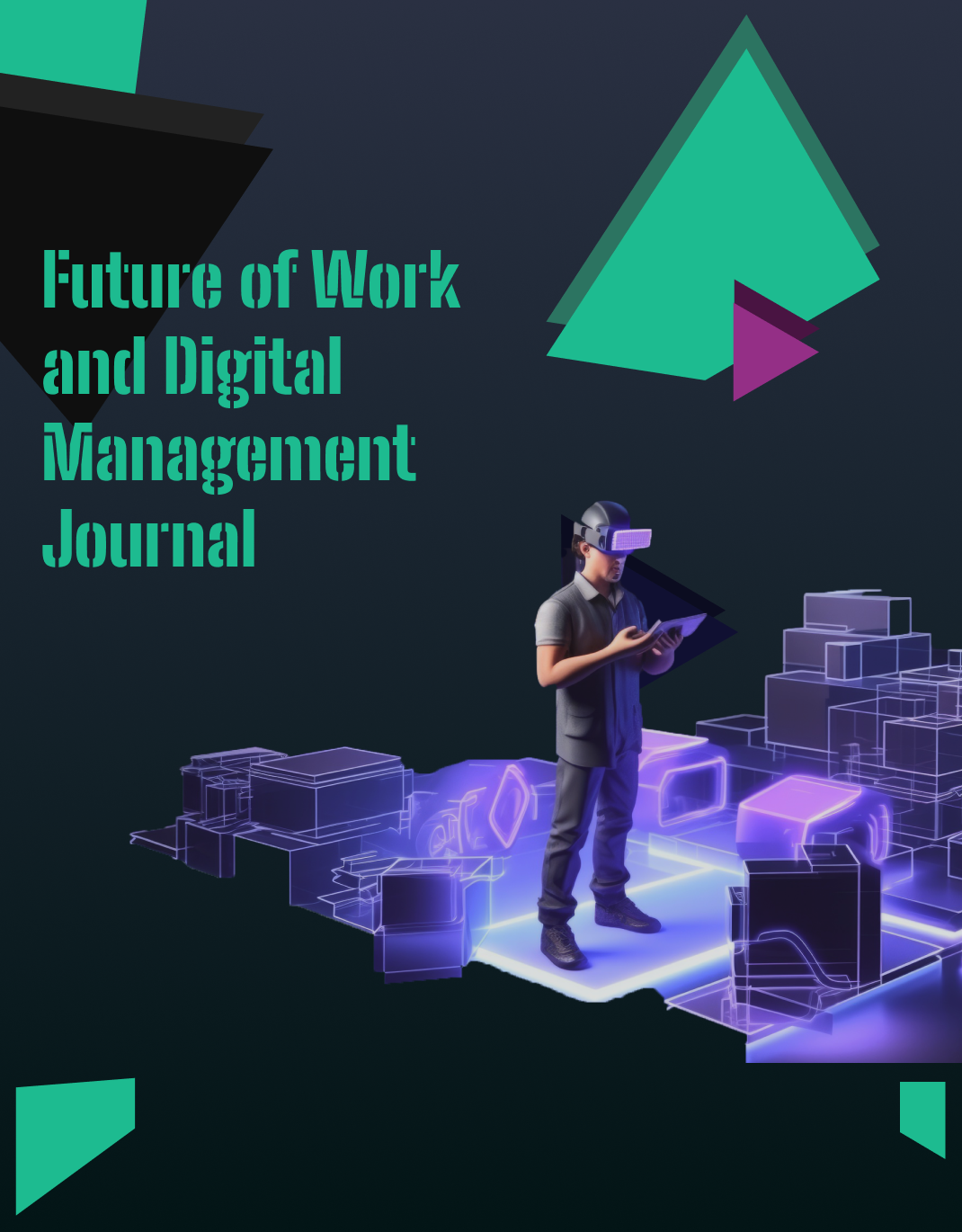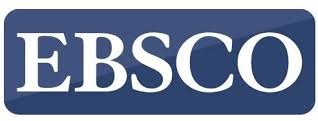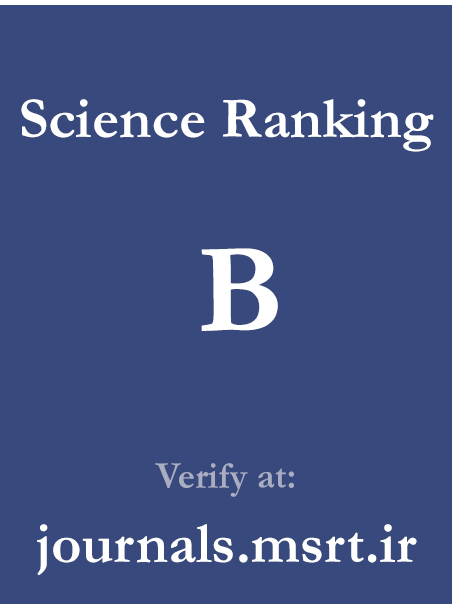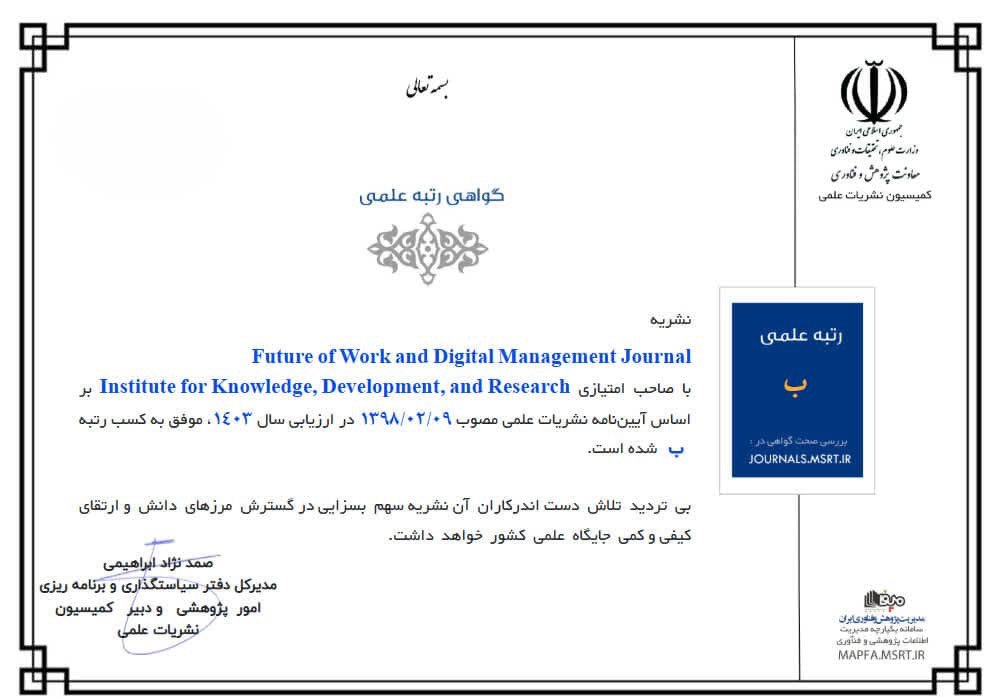Design and Validation of a Self-Directed Learning Management Model in Organizational Training at Bank Sepah
Keywords:
Self-directed learning, Bank Sepah, learning culture implementation, individual capabilities, grounded theory analysis, interpretive structural modeling (ISM)Abstract
Due to their inherently competitive nature in attracting customers and financial resources, as well as their continual exposure to unpredictable fluctuations in both domestic and international economies, banks face a constant need to enhance their knowledge competencies. One of the key approaches in organizational learning management is the adoption of self-directed learning. The present study was conducted with the aim of designing and validating a self-directed learning management model for organizational training programs at Bank Sepah. This study is applied in its objective and employs a mixed-methods design in terms of methodology. In the qualitative phase, data were analyzed using the grounded theory approach. The required data were collected through semi-structured and in-depth interviews and analyzed based on a coding process. Sampling in this phase was theoretical, utilizing purposive and snowball techniques. In total, open interviews were conducted with 12 banking managers and academic experts. Through open coding, a set of initial themes was extracted and then categorized into conceptual components. Preliminary analysis of the interviews led to the identification of 158 initial codes. In the second stage of coding, after examining the initial codes and analyzing their similarities and differences, 112 codes were grouped into 20 categories, which were organized under the systematic paradigm model, including causal conditions, contextual conditions, strategies, intervening conditions, and outcomes. Using this approach, all dimensions and components influencing self-directed learning were comprehensively covered. In the quantitative phase, the number of experts was 23, and sampling was conducted using the convenience sampling method. The statistical population consisted of managers and employees of the bank, through whom model validation and survey data collection were carried out. To achieve the research objectives and answer the study questions, the factors identified in the qualitative phase were used as inputs for interpretive structural modeling (ISM), through which the hierarchical levels were determined. Accordingly, the “individual capabilities” index was identified as the foundational and core element of the self-directed learning model in organizational training at Bank Sepah.
Downloads
References
[1] J. W. Lounsbury, J. J. Levy, S. Park, L. W. Gibson, and R. Smith, "An investigation of the construct validity of the personality trait of self-directed learning," Personality and Individual Differences, vol. 19, pp. 411-421, 2024, doi: 10.1016/j.lindif.2009.03.001.
[2] G. S. Shokar, N. K. Shokar, C. M. Romero, and R. J. Bulik, "Self-directed learning: looking at outcomes with medical students," Medical Education, vol. 34, no. 3, pp. 197-200, 2023. [Online]. Available: https://edujournal.zums.ac.ir/browse.php?a_id=1792&slc_lang=en&sid=1&ftxt=1&html=1.
[3] S. N. Williamson, "Development of a self-rating scale of self-directed learning," Nurse Researcher, vol. 14, no. 2, pp. 66-83, 2022, doi: 10.7748/nr2007.01.14.2.66.c6022.
[4] M. S. Knowles, Self-directed learning: A guide for learners and teachers. Chicago: Follett Publishing, 2018.
[5] A. A. Saif, "Constructivist Learning Theories and Their Educational Applications," Scientific-Research Journal of Education, vol. 76, pp. 61-75, 2020. [Online]. Available: https://ensani.ir/fa/article/168231/.
[6] A. P. Sawatsky, R. Ratelle, S. Bonnes, J. Egginton, and T. Beckman, "A model of self-directed learning in internal medicine residency: a qualitative study using grounded theory," BMC Medical Education, vol. 17, no. 31, pp. 25-42, 2023, doi: 10.1186/s12909-017-0869-4.
[7] M. Talebzadeh Shushtari and I. D. B. Z. Boyeri, "Design and test of a causal model of self-directed learning based on emotional creativity, tendency to critical thinking and academic vitality with the mediation of achievement motivation," Journal of Psychological Sciences, vol. 23, no. 137, 2024. [Online]. Available: https://psychologicalscience.ir/article-1-2205-fa.html.
[8] F. A. Abdollahi Adli Ansar and Alai, "The Role of Readiness for Self-Directed Learning and Critical Thinking Attitude in Predicting Academic Performance of Students at Tabriz University," Journal of Psychology, Tabriz University, vol. 5, no. 17, pp. 85-105, 2023. [Online]. Available: https://psychologyj.tabrizu.ac.ir/article_4215.html.
[9] A. Ghasemzadeh Alishahi, M. Razaghi, and F. Masoumi Kia, "The Role of Learning and Educational Environment on Job Performance: The Contribution of Learning Capacity Variable," Journal of Educational Management of Organizations, vol. 9, no. 1, pp. 174-147, 2020. [Online]. Available: https://journalieaa.ir/article-1-144-fa.html.
[10] R. Hasanvandi and M. Ramadan, "Increasing Organizational Intellectual Capital: Investigating the Role of Organizational Learning," Journal of Management Improvement, vol. 5, pp. 27-41, 2019. [Online]. Available: https://www.behboodmodiriat.ir/article_42760.html.
[11] A. Moghadam Zadeh, Z. Ali Akbari, and E. Mazari, "The Relationship between Self-Directed Learning and Organizational Learning in Educational Organizations," Journal of Organizational Culture Management, vol. 6, no. 4, pp. 827-850, 2018. [Online]. Available: https://www.sid.ir/paper/383983/fa.
[12] K. Grover and M. Miller, "An Examination of the Self-Directed Learning Practices of ESL Adult Language Learners," Journal of Adult Education, vol. 43, no. 2, pp. 37-56, 2018. [Online]. Available: https://scispace.com/pdf/an-examination-of-the-self-directed-learning-practices-of-1fnszdapps.pdf.
[13] T. Seng Chee, L. Tan, S. Divaharan, and C. Hourn Mun, Self-Directed Learning with ICT: Theory, Practice and Assessment. Ministry of Education Educational Technology Division, 2021.
[14] J. Macintyre, J. Zhao, and X. Ma, "The Innovation of Student Education Management Model Based on Internet Technology," in The International Conference on Machine Learning and Big Data Analytics for IoT Security and Privacy, 2021, vol. 98, pp. 65-78. [Online]. Available: https://link.springer.com/content/pdf/10.1007/978-3-030-89511-2.pdf.
[15] D. Yang, "The Mediating Role of Psychological Capital on the Relationship Between Perceived Stress and Self-Directed Learning Ability in Nursing Students," BMC Nursing, vol. 23, no. 1, 2024, doi: 10.1186/s12912-024-02094-6.
[16] F. Xiu-Juan, C. Xiao-Hui, L. Huan, and L. Xiang-Xiang, "Serial multiple mediation of psychological capital and self-directed learning ability in the relationship between perceived stress and professional identity among undergraduate nursing students in China: a cross-sectional questionnaire survey," BMC Medical Education, vol. 24, p. 1450, 2024, doi: 10.1186/s12909-024-06459-y.
[17] A. Strauss and J. Corbin, Foundations of Qualitative Research: Techniques and Stages of Grounded Theory Production. Tehran: Nashr-e Ney, 2015.
[18] J. Kersoul, Qualitative Inquiry and Research Design: Choosing Among Five Approaches (Narrative Research, Phenomenology, etc.). Tehran: Safar, Eshraghi, 2023.
[19] Y. Beikkhakhian, M. Javanmardi, M. Karbasian, and B. Khayambashi, "The application of ISM model in evaluating agile supplier's selection criteria and ranking suppliers using fuzzy TOPSIS-AHP methods," Expert Systems with Applications, vol. 42, no. 1, pp. 6224-6236, 2015, doi: 10.1016/j.eswa.2015.02.035.
[20] A. Jindal and K. S. Sangwan, "Development of an interpretive structural model of drivers for reverse logistics implementation in Indian industry," International Journal of Business Performance and Supply Chain Management, vol. 5, no. 4, pp. 325-342, 2013, doi: 10.1504/IJBPSCM.2013.058201.
[21] S. Sindhu, V. Nehra, and S. Luthra, "Identification and analysis of barriers in implementation of solar energy in Indian rural sector using integrated ISM and fuzzy MICMAC approach," Renewable and Sustainable Energy Reviews, vol. 62, pp. 70-88, 2016, doi: 10.1016/j.rser.2016.04.033.
[22] L. Olfat, "A Model of Factors Influencing Logistics Outsourcing Decisions Using Interpretive Structural Modeling," Iranian Journal of Management Sciences, vol. 11, no. 42, pp. 1-24, 2016. [Online]. Available: http://journal.iams.ir/article_230.html?lang=en.
[23] F. a.-D. Khezri, "Investigating the Impact of Participatory and Combined Methods on Self-Regulation and Academic Progress in Science for Sixth-Grade Students in Multi-Grade Classes in Piranshahr County," Master's Thesis, Allameh Tabatabai University, Tehran, 2023. [Online]. Available: https://civilica.com/doc/1222969/
[24] M. Fisher, J. King, and G. Tague, "Development of self-directed learning readiness scale for nursing education," Nurse Education Today, 2019. [Online]. Available: https://papers.iafor.org/wp-content/uploads/papers/eri2022/ERI2022_63030.pdf.
[25] R. Pittayarat Yamprayoon and R. Jermtaisong, "Learning Management Based on Language Teaching for Communication Combined with Grouping Techniques to Develop Chinese Speaking Skills for Everyday Use of Secondary 4 Students," Advances in Social Science, Education and Humanities Research, vol. 250, pp. 42-58, 2020. [Online]. Available: https://www.atlantis-press.com/proceedings/tvet-20/125952281.
[26] H. Bembenutty, "Self-Regulation of Learning and Academic Delay of Gratification: Gender and Ethnic Differences among College Students," Journal of Advanced Academics, vol. 18, no. 4, pp. 586-616, 2019. [Online]. Available: https://journals.sagepub.com/doi/10.4219/jaa-2007-553.
Downloads
Published
Submitted
Revised
Accepted
Issue
Section
License
Copyright (c) 2026 Hoda Faraji, Fatemeh Ahmadbeigi, Zahra Sabbaghian (Author)

This work is licensed under a Creative Commons Attribution-NonCommercial 4.0 International License.







